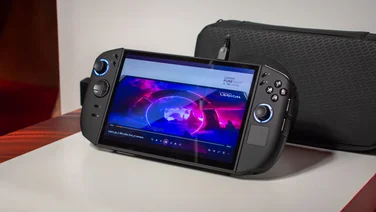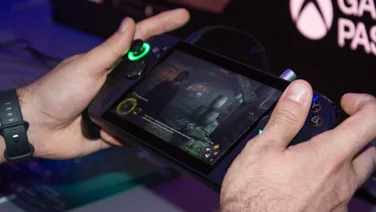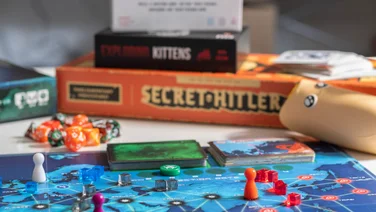To help us provide you with free impartial advice, we may earn a commission if you buy through links on our site. Learn more










- Impressive performance and energy efficiency
- Bright screen and immersive sound
- Runs the full range of PC games
- Software has inconsistencies
- Big, heavy and expensive
There has been speculation about an Xbox handheld for years, and the ROG Xbox Ally and ROG Xbox Ally X are about as close as we’re probably going to get. They aren’t the Xbox handheld running Xbox software that Microsoft is rumoured to have cancelled earlier this year, but are the first PC handhelds to run a new version of the Xbox app, designed to transform the user experience to make it more handheld-friendly and Xbox-like.
Asus has worked closely with Microsoft to deliver hardware worthy of the Xbox name. However, software has always held Windows-based handhelds back; the two new Allys have a chance to turn this around and make Windows gaming handhelds as consistent and usable as their SteamOS rivals.
Of the two, the ROG Xbox Ally X has a clear advantage. It’s one of the most powerful handhelds and is capable of running the full gamut of Xbox (and other PC) games. But can it deliver the real Xbox experience? I’ve been testing it over the last week to find out.
What you need to know
The higher-end model, the ROG Xbox Ally X, is one of the most powerful PC gaming handhelds out there, combining the new AMD Ryzen Z2 Extreme processor with 24GB of RAM and 1TB of storage. It packs in a 7in, 120Hz 1080p display and Xbox-style controls, along with a large 80Wh battery.










It runs Windows 11, but with a revamped user experience based on the Xbox app, providing easy access to Xbox PC and Xbox Game Pass titles, plus games you own through other services, including GOG, Ubisoft Connect, EA Play, the Epic Games Store and Steam. It also adds some performance optimisations to ensure that more system resources are targeted at running games rather than unnecessary background processes.
Just to be clear, it doesn’t run Xbox games in the sense of games you’ve bought and played on an Xbox console. Instead, it runs the PC versions, including games you purchase through the Microsoft Store on Xbox or Windows and supports Microsoft’s Xbox Anywhere programme, along with any games you download through Xbox Game Pass. Most of these titles allow cross-save, so you can switch between your console, the handheld and a laptop or desktop PC and maintain your progress across all of them. However, this doesn’t mean other Xbox games you might have purchased, especially those from third parties, will show up in your ROG Xbox Ally X’s library. Frankly, many won’t.
Price and competition
The ROG Xbox Ally X is a premium handheld that costs £799, compared with the ROG Xbox Ally’s more wallet-friendly £499. It’s the same price as the existing, non-Xbox ROG Ally X, but a little cheaper than its two biggest (in every way) competitors, the MSI Claw 8 AI+ and Lenovo Legion Go 2. Both cost £899 and are formidably powerful handhelds, with the MSI Claw using a laptop-class Intel Lunar Lake Core Ultra 7 processor, and the Legion Go 2 using the same Ryzen Z2 Extreme.
These are the major Windows rivals, but the Xbox Ally X also faces competition from SteamOS-based devices. The Steam Deck OLED isn’t as powerful, but it’s still a great handheld and can be had for £570 with a 1TB SSD. Meanwhile, the Lenovo Legion Go S comes with a choice of Ryzen Z2 Go and Z1 Elite processors for between £549 and £699.
Going with SteamOS cuts you off from the full range of PC gaming services and game stores (though there are workarounds), but Valve’s lean and gaming-focused software has so far been a better fit for handhelds.
Design and connectivity
From the moment you pick the ROG Xbox Ally X up, it’s clear that the objective is to make the experience as Xbox-like as possible. The two grips help it mimic the feel of Microsoft’s controller, down to the positioning of the rumble motors and the placement of the bumpers and triggers. The grips are textured to make them easier to grasp onto, and angled slightly away from the screen for a more comfortable hold. The basic control layout will be very familiar, and while Xbox gamers might not be used to the RGB-illuminated rings around the analogue sticks, such things are to be expected. This is an Xbox and ROG collab, after all.
It’s also a big handheld, measuring nearly 291mm wide and 121.5mm from top to bottom. The central area behind the screen is up to 29mm thick, and the 715g weight only seems reasonable because I’ve spent time with the 795g MSI Claw 8 AI+. Yet the grips help make it the most ergonomically satisfying handheld I’ve used yet. It’s playable for hours with no sign of hand cramps, especially if you can rest it on your knee or chest from time to time.










The connectivity is at the top, just above the beefy vents that help move hot air quickly from the key components. On the left, there’s one USB 4 Type-C port with DisplayPort 2.1, USB PD 3.0 and Thunderbolt 4 support, along with a second USB 3.2 Gen 2 Type-C port with all the above bar Thunderbolt 4. On the right, there’s a microSD card slot and a 3.5mm headphone socket. It’s a little disappointing that there’s no microSD Express card support, but you can still run many PC games from a fast microSD card without murdering performance, as most Steam Deck owners will know.
Controls
I wouldn’t say the ROG Xbox Ally X has identical controls to an Xbox controller, but it’s very close. The two analogue sticks have more pronounced outer rings for a superior grip, while the triggers are much wider, with a textured area in the middle of the glossy surface for your fingertips to latch onto. The all-important Xbox button sits next to the left thumbstick, with the View button and a button for Asus’s Armory Crate control panel just next door. Just above the right stick, you’ll find the Menu button and a shortcut button for your games library. Around the back, there are two small-ish paddles with customisable functions.










Crucially, there’s barely anything that’s going to upset you or feel unfamiliar if you’re switching between an Xbox and the ROG Xbox Ally X. The sticks feel much the same and seem to have broadly similar levels of sensitivity, so no problems there. The face buttons aren’t identical, but they feel robust and perfectly responsive. The triggers and bumpers have a nice click, with the former delivering the kind of analogue response you need for driving games and the signature Impulse Trigger vibration feedback we’ve had on Xbox since the Xbox One. I don’t think you could have a handheld that felt much more like an Xbox, even if it was built by Microsoft itself.
Control modes
Like most Windows handhelds, the ROG Xbox Ally X has two control modes. You can navigate the Xbox and Armory Crate apps, plus the Steam app, without switching from the main Gamepad control mode, but for controlling other apps, you’ll need to switch to the Desktop mode.










Here, the left stick flicks from icon to icon and button to button, with the right stick controlling an onscreen pointer and the right bumper and trigger handling mouse buttons 1 and 2, respectively. It sort of works, but it’s less than ideal, and I found the touchscreen slightly inaccurate and sometimes unresponsive. Even more than with the MSI Claw 8 AI+, I’d recommend a Bluetooth mouse for getting any serious setup work done.
Software
The ROG Xbox Ally X’s software has some good points and some not-so-good points. On the positive front, it’s great to launch straight into the Xbox app in full-screen mode and launch games without messing around with Windows or weird launcher apps.
Having the Xbox Game Bar available at a click, with instant access to volume controls, Xbox friends lists, key settings, and recently played games, makes a lot of sense and gives the handheld a much more Xbox-like feel. It’s also brilliant that Microsoft has integrated the other major gaming apps, allowing you to install them, access them and then launch your games from within a single interface. I don’t think I have used a Windows gaming PC ecosystem that feels so coherent.
Yet the cracks keep on appearing. To install and manage games from other services, you’ll still need to use the relevant apps, and these are either not so handheld-friendly or, like Steam in Big Picture mode, a bit odd when used within a Windows handheld. At times, using the ROG Xbox Ally X can feel like you’re using an emulated Steam Deck inside an Xbox inside a Windows PC. At other times, you’re left wondering why some key functions and settings are duplicated or split between the Xbox App and Asus’s Armory Crate. It all works, but it’s weird and not particularly intuitive.










This stuff isn’t Asus’s fault or even Microsoft’s, but it doesn’t help. What’s more, I still found times when a browser window or a Windows message would pop up outside the core interface and need to be dealt with before a game would set up or load, and times when I needed to tap the screen before the gamepad controls took over and I could press the button marked to select an option or launch a game. I’ve encountered long and painful pauses while a game loads in another window, leaving me to think that it wasn’t running. I’ve been a PC gamer for over thirty years. I’m used to this malarky. People coming from a console background might be wondering what is going on.
Microsoft has added a new indicator in Game Pass and the store to tell you whether games should run on the handheld, but it’s early days, and some new titles aren’t covered. It’s certainly not as effective nor as reliable as Steam’s Verified/Playable badges. Meanwhile, gamers coming from the Xbox could still be frustrated by some inconsistencies in games pausing and restarting when you put the device to sleep, and by the lack of a quick resume feature.










Overall, I still wish that Microsoft would go the whole hog and build a version of the Xbox OS or a custom version of Windows designed to get the most out of these handheld PCs. It would clear many of these issues up and create a software experience as slick and familiar as the hardware.
Display
In an ideal world, the ROG Xbox Ally X would have a slightly larger display and it would be OLED, but in the world we live in, the 7in LCD screen is more than fit for purpose. I don’t think there’s any benefit to going beyond the 1,920 x 1,080 resolution on a 16:9 aspect ratio panel, and it’s a very crisp and vibrant picture. Playing games from Doom: The Dark Ages to Forza Horizon 5 to Indiana Jones and the Great Circle, I’ve been struck by how big and immersive the experience is for a handheld device. As long as you’re not expecting eyeball-searing HDR (which isn’t supported), games look spectacularly good.










In my technical tests, the screen holds up pretty well. I measured maximum brightness levels at 481cd/m2, with a black level of 0.35cd/m2 and a respectable contrast ratio of 1364:1. Colour performance is decent, with 95% coverage of the sRGB gamut and 68.3% coverage of DCI-P3. Colours are accurate enough for image-editing, with an average Delta E of 1.2. Of course, nobody is going to do that on a screen this size, but it goes to show how much effort Asus has put into selecting its components.
Asus also deserves kudos for the sound. At moderate volume levels, it’s bigger and more impactful than on other handhelds I’ve sampled, with some impressive stereo separation to steer gunshots and shrieks around the soundstage. You can have a great time playing games without plugging any headphones in, though you might want to if you’re sharing the room with anyone else. At higher volume levels, there’s some compression and distortion, but you’ll probably want to keep things lower to avoid a headache.
Performance
Perhaps the best thing about the ROG Xbox Ally X is that it has enough power to run pretty much any title in your Xbox Games Pass library – or your Steam or GOG libraries, for that matter. Sure, you’ll be running some titles at low to medium detail settings and without ray tracing, and with some, you might want to switch down from 1080p to 720p to keep the frame rate between 40fps and 60fps. You’ll also want to make judicious use of FSR upscaling. With all that in mind, though, nothing much is off the cards.
The Xbox Ally X offers four preset performance modes: Silent at 13W, Performance at 17W and Turbo at 25W. However, when plugged in, the TDP of the latter mode rises to 35W. In practice, I found this can add between 2fps and 4fps to frame rates, depending on the game. Since the original review was in progress, I’ve retested the Xbox Ally X in the 25W Turbo mode to make sure the figures reflect what you’ll get when not plugged in.
In synthetic benchmarks, it trades blows with the MSI Claw 8 AI+. In the 3DMark TimeSpy test, the Claw hits 4381 at 37W and 4402 at 30W to the ROG Xbox Ally X’s 4067 at 35W, 3851 at 25W and 3397 at 17W. However, in the Steel Nomad (Lite) benchmark, the Xbox Ally X pulls ahead with 3366 at 35W and 3349 at 25W to the Claw’s 3284 at 37W and 3285 at 30W. At 17W, the Asus can still dish out a credible 3200W.










In actual games, the picture is slightly confused because the ROG Xbox Ally X has to run some titles at 720p rather than 800p, but it’s very close at these low resolutions and settings. Running at 30W, the Claw 8AI+ scores 67fps in the Cyberpunk 2077 benchmark at 800p with Steam Deck settings, and 75fps with XESS Balanced upscaling. The Xbox ROG Ally X at 35W can do 64fps without upscaling and 82fps with FSR3 Balanced, while at 25W, you’re looking at 62fps and 75fps.
Switch up to 1080p without upscaling, and the Asus scores 40fps to the Claw’s 39fps at 35W and 37W, or 37fps on battery power at 25W. If you’re happy with a sub-60fps frame rate (and I would be), you can get 59fps with FSR3 balanced at 1080p Medium settings while plugged in, or 57fps running unplugged. The Claw can do 60fps, but that’s hardly a noticeable difference.
Move to Forza Horizon 5 and it’s much the same story. You’re looking at 55fps at 1080p High settings without upscaling, where the Claw scored 53fps and 56fps at 1080p with FSR 2.2 where the Claw scored 55fps. Dropping down to 25W on battery doesn’t significantly degrade performance. And while both struggle to maintain a playable frame rate in Doom: The Dark Ages at 1080p Medium settings, both can give you a playable experience at 720p Medium settings with upscaling, with the ROG Xbox Ally X hitting 48fps and the Claw 44fps. On battery power at 25W, the Xbox Ally X still pulled ahead of the Claw with 45fps.
Sticking to Turbo mode will see you take a hit on battery life, but switching down to the 17W Performance mode doesn’t kill performance. You’ll lose some FPS, but you can still get 57fps in Doom: The Dark Ages at 720p with Low settings and upscaling, or 45fps in Forza Horizon 5 with High settings at 1080p. Even Cyberpunk is playable at 1080p Medium settings with upscaling, at 43fps.










Anecdotally, I tried the ROG Xbox Ally X on some of the most demanding titles in the Games Pass library, including Indiana Jones and the Great Circle and Call of Duty: Black Ops 6. Sure, I couldn’t hit 60fps even with upscaling, but 35 to 45fps was consistently possible, particularly if I made some compromises on the detail settings or the resolution. With my eyes on the game rather than the frame rate counter, they all played smoothly and were perfectly enjoyable, both at 17W and 25W. To be honest, it’s just gobsmacking to see some of the most visually advanced games out there looking so good on a handheld device.
The ROG Xbox Ally X is also more than capable of running as a general-purpose PC, though you’ll want to have it connected to a mouse, keyboard and monitor via a dock. Its scores of 2776 (single-core) and 10961 (multi-core) wouldn’t disgrace a decent budget laptop, and it has a 50TOPS NPU for AI processing. It scored 336 in our 4K media benchmarks, beating the Claw 8 AI+’s performance, not to mention many recent budget and mid-range productivity laptops. Speed really isn’t a problem here.
The power efficiency of the Ryzen AI Z2 Extreme and the 80Wh battery also seem to have had a positive impact on battery life. At 17W, I could comfortably play Indiana Jones and the Great Circle for around two hours and forty minutes, and it still looked impressive. At 25W, playing Doom: The Dark Ages saw the battery drain in just under two hours. Less demanding games can run for three to four hours without any problems, while the Asus was a monster in our video rundown test, lasting 18hrs 39mins before running out of charge. No other gaming handheld we’ve tested so far has even come close.
Verdict
We’ve yet to test the Lenovo Legion Go 2, but this is the best premium gaming handheld that I’ve tested. It’s extremely comfortable, the controls are hard to fault, and it has the performance to run AAA titles. There is room for improvement on the software front – here, SteamOS still offers a more robust and coherent UI – but the new Xbox app is a serious step in the right direction, and has some advantages in terms of game support.
In short, I would happily buy this handheld myself, and the only reason I won’t is the reason many other people won’t, which is the price. At £799, I actually think the ROG Xbox Ally X is pretty good value. It’s the same price as the ROG Ally X launched at, and £100 or more cheaper than both the MSI Claw 8AI+ and the Legion Go 2. Yet it’s still an awful lot of money for a gaming handheld, especially when the software experience isn’t quite where it should be yet.
Still, for the serious gamer or Xbox aficionado with more disposable income, the Xbox ROG Ally X is an easier recommendation. It’s the new high-end handheld to beat.






